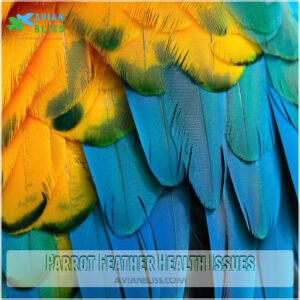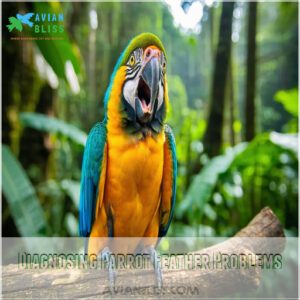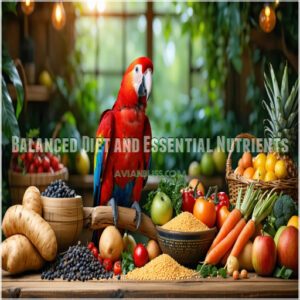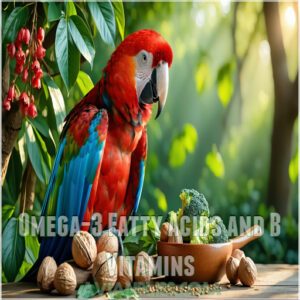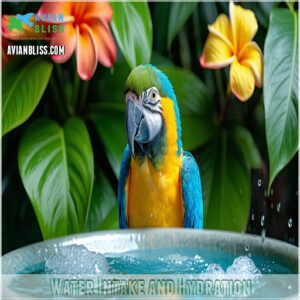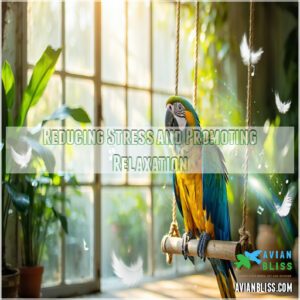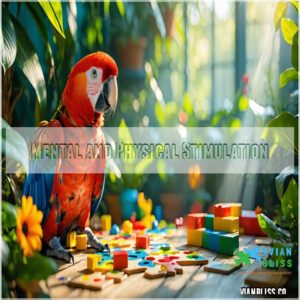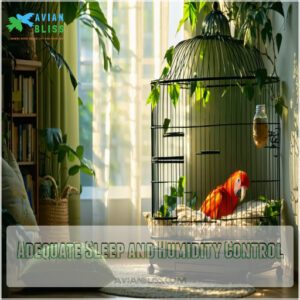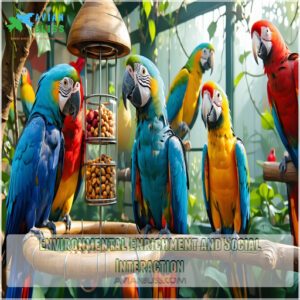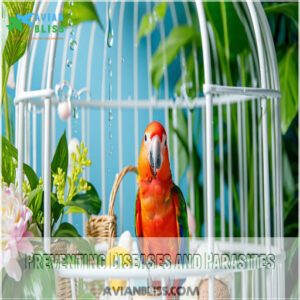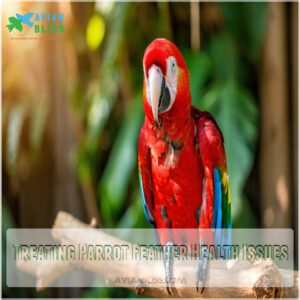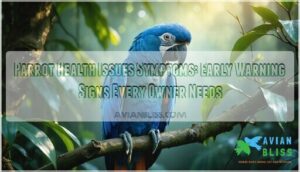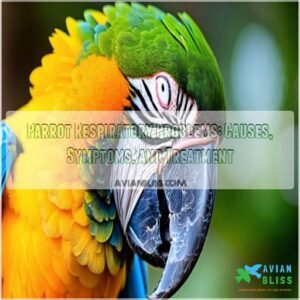This site is supported by our readers. We may earn a commission, at no cost to you, if you purchase through links.
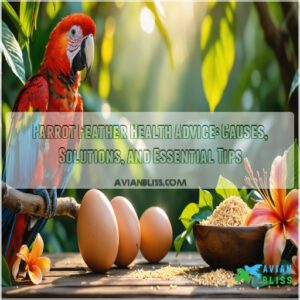
To keep those feathers in top shape, you’ll need a balanced diet rich in proteins and vitamins, especially from sources like eggs, quinoa, and leafy greens.
Don’t forget the importance of sunlight and proper humidity – think of it as your bird’s personal spa day.
Regular monitoring helps catch issues early, while a stress-free environment keeps those feathers gleaming.
Just like us, parrots thrive on good nutrition and TLC, and there’s a surprising superfood that can transform your bird’s plumage overnight.
Table Of Contents
- Key Takeaways
- Parrot Feather Health Issues
- Diagnosing Parrot Feather Problems
- Nutrition for Healthy Parrot Feathers
- Managing Parrot Stress and Environment
- Treating Parrot Feather Health Issues
- Frequently Asked Questions (FAQs)
- What do unhealthy bird feathers look like?
- Do fallen bird feathers carry disease?
- How to keep bird feathers healthy?
- How can I improve my parrot feathers?
- How often should I bathe my parrot?
- When do baby parrots start growing their feathers?
- Can indoor lighting affect feather color and quality?
- Are certain parrot breeds more prone to feather problems?
- Should parrots be exposed to direct sunlight outdoors?
- Conclusion
Key Takeaways
- Your parrot’s feather health depends on a balanced diet rich in proteins, vitamins, and omega-3 fatty acids – include high-quality pellets, fresh fruits, vegetables, and supplements to maintain vibrant plumage.
- You’ll spot health issues early by monitoring changes in feather appearance – watch for dullness, breakage, stress bars, or abnormal molting patterns that signal underlying problems.
- You can prevent stress-related feather damage by providing 10-12 hours of sleep, maintaining 40-60% humidity, and creating an enriched environment with toys and social interaction.
- You’ll need to act quickly when you notice feather problems – work with a vet to address nutrient deficiencies, parasites, or infections while providing supportive care in a calm environment.
Parrot Feather Health Issues
Your parrot’s feathers can reveal a lot about its health, and changes like dullness, breakage, or feather loss shouldn’t be ignored.
Recognizing these signs early can help you address potential problems and keep your bird healthy.
You should be aware that early recognition of these signs is crucial for maintaining your parrot’s well-being.
Dull Coloration and Breakage
Dull feathers and breakage often signal parrot feather problems caused by diet, UV light deficiency, or poor plumage care.
Feather fading or color loss might stem from malnourishment, while breakage causes include environmental factors or mishandling.
Provide a balanced diet, access to sunlight, and a safe habitat to maintain vibrant plumage.
These simple steps boost parrot feather health effectively.
Regular monitoring of feather condition can help identify feather health issues early on, which is crucial for overall parrot health and feather care.
Ruffled Plumage and Feather Loss
Ruffled feathers and parrot feather loss can signal underlying issues.
Poor feather condition often points to diet, stress, or health concerns. Proper plumage care, like regular bird grooming and monitoring the molting process, supports feather health.
For feather repair, maintain balanced nutrition and a clean environment.
Follow feather health advice to address parrot molting issues early, promoting vibrant, healthy feathers.
Stress Bars and Feather Texture Changes
Stress bars and feather texture changes often hint at deeper issues in your parrot’s environment or diet.
These subtle stress signals, like faint lines across feathers or unusual feather breakage, often emerge from poor parrot stress management.
For better feather health, provide balanced nutrition, consistent care, and a calm environment.
Follow this parrot feather health advice to prevent feather damage.
Understanding feather plucking stress is essential for addressing these issues effectively, and is crucial for parrot stress management and overall well-being.
Self-Inflicted Damage and Feather Plucking
Parrot feather plucking and self-inflicted damage often stem from stress, boredom, or poor health.
Spotting signs like feather chewing, feather breakage, or stress bars early is essential.
Providing toys, mental stimulation, and a balanced diet helps reduce feather destructive behavior.
If feather plucking persists, consult a vet—self-mutilation may indicate deeper issues like illnesses or improper environments.
Abnormal Molting Patterns and Disrupted Regrowth
Abnormal molting patterns can mess up your parrot’s feather regrowth, leaving their plumage dull and uneven.
If molting cycles seem off, it might signal feather damage, stress, or health issues.
Check for signs like delayed regrowth patterns or missing feathers.
Following parrot feather health advice, make sure proper nutrition, reduce stress, and consult a vet to keep their feather growth on track, ensuring overall parrot feather health.
Diagnosing Parrot Feather Problems
When your parrot’s feathers look dull, ruffled, or damaged, it’s a clear sign that something’s wrong.
By observing their appearance and behavior closely, you can catch early warning signs and address potential health issues effectively.
Visual Inspection and Behavioral Changes
Keep an eye on feather condition and behavioral signs for early health warnings.
Visual inspection helps spot plumage changes, like dull feathers or irregular molting. Notice behavioral changes like lethargy, aggression, or unusual scratching—these are key health indicators.
Quick action based on visual cues guarantees your parrot stays happy and thriving. Follow practical parrot feather health advice for peace of mind.
Ruling Out Parasites and Infections
Spotting Infection Signs gets easier with close observation.
Watch for feather mites causing bald patches or air sac mites triggering respiratory infections. Parasitic conditions like lice lead to rough, chewed feathers.
Beak Diseases signal bacterial or viral problems. Fungal infections often appear as crusty patches or odd smells.
Parasite control protects feather quality. Beak and feather issues can be caused by viral disease factors that affect parrot health and are related to viral disease.
Supportive Care and Rehabilitation
After addressing infections, focus on supportive care and rehabilitation. Gentle handling builds trust, while social interaction helps ease distress.
Create calm environments to reduce overstimulation and focus on stress management. Feather health supplements and a balanced diet support regrowth.
Rehabilitation techniques, guided by avian health experts, guarantee your bird feels safe and nurtured. Consistent care enhances parrot feather care and overall well-being.
Monitoring for parrot health issues is essential for early detection and effective treatment of various diseases, ensuring complete recovery.
Nutrition for Healthy Parrot Feathers
Your parrot’s feathers rely on a balanced diet filled with essential nutrients to stay vibrant and strong.
Providing high-quality pellets, fresh fruits, vegetables, and adequate hydration promotes robust feather health and growth.
Balanced Diet and Essential Nutrients
A balanced diet is key to vibrant feather growth and overall health.
Tailor your parrot’s nutrition with these essentials:
- High-quality pellets for core nourishment.
- Vitamin-rich foods like sweet potatoes and carrots.
- Balanced proteins to support feather regrowth.
- Parrot dietary supplements as needed.
Proper nutrient balance maintains your bird’s feathers healthy, colorful, and strong.
For superior nutrition, consider parrot food options when selecting a diet.
Protein-Rich Foods and Vitamin a Sources
For stronger feathers, focus on parrot nutrition advice emphasizing protein-rich foods and vitamin A.
Egg nutrition and quinoa benefits boost feather growth, while sweet potato and kale sources improve coloration.
Parrot protein from fish oil or chickpeas aids regrowth, and these parrot diet supplements guarantee vibrant, healthy plumage.
Prioritize natural foods for best parrot feather nutrition.
Omega-3 Fatty Acids and B Vitamins
For healthy plumage and feather growth, include omega-3 fatty acids and B vitamins in your parrot’s nutrition.
Fatty Acid Benefits support skin health, while B vitamins promote regrowth.
Foods like nuts, flaxseed, and broccoli are excellent sources.
Vitamin Supplements or parrot feather supplements can fill gaps in their diet, ensuring Nutrient Balance for vibrant feathers and peak parrot health, with B vitamins playing a crucial role.
High-Quality Pellets and Fresh Fruits and Vegetables
Eating high-quality pellets forms a solid base for your parrot’s nutrition.
Combine that with fresh foods like a variety of fruits and vegetables for a balanced diet that supports healthy parrot feathers.
Fruit variety keeps meals interesting, while veggie benefits range from vitamins to fiber.
Balanced bird nutrition is key to shiny, vibrant plumage and overall parrot health.
A parrot’s diet should include proper parrot food pellets to make sure best nutrition.
Water Intake and Hydration
Maintain water quality by offering fresh, clean water daily—stale water invites illness.
Monitor your parrot’s drinking habits; subtle changes might signal dehydration.
Parrot water intake varies, but around 20-30 ml per 100g of body weight works.
Follow these parrot health tips, as hydration supports vibrant plumage and overall well-being.
Managing Parrot Stress and Environment
Creating a stress-free environment is essential for your parrot’s feather health and overall well-being.
By providing mental stimulation, comfortable surroundings, and proper care, you can support their relaxation and prevent stress-related issues.
Reducing Stress and Promoting Relaxation
Creating a stressfree environment for your parrot is key to reducing stress and promoting relaxation.
Calming techniques like maintaining a quiet space, consistent routines, and gentle interactions help ease anxiety.
Stress reduction starts with recognizing parrot behavior changes, such as feather plucking or irritability.
Simple relaxation methods, like dimming lights or soft music, can work wonders for their well-being.
Mental and Physical Stimulation
Interactive toys and activities work wonders for mental stimulation and stress management.
Environmental enrichment encourages curiosity, while regular social interaction keeps your parrot engaged and happy.
For stress reduction, vary routines with puzzles or foraging games.
Behavioral therapy, like training simple tricks, strengthens bonds and builds confidence.
This parrot feather health advice guarantees a happier, healthier bird with improved mental well-being. Recognizing stress signs quickly is critical for providing the right care and attention to your parrot.
Adequate Sleep and Humidity Control
Good sleep patterns are essential for parrot feather health. Make sure yours sleeps 10-12 hours nightly in low light and minimal noise for ideal relaxation.
Proper humidity levels (40-60%) prevent dryness that impacts feather growth. Use a humidifier to improve air quality and hydration.
Balanced conditions enhance comfort, offering practical parrot feather health advice while supporting their overall well-being. Maintaining balanced humidity is essential, and understanding parrot humidifier systems can help achieve this balance to ensure proper humidity.
Environmental Enrichment and Social Interaction
Beyond quality sleep, your parrot’s feathers thrive in an enriched environment that sparks joy and social bonding.
You’ll notice healthier plumage when you design an aviary that encourages natural behaviors. Here’s what successful environmental stimulation includes:
- Rotate toys weekly to prevent boredom and maintain curiosity
- Place foraging stations at different heights for exploration
- Set up climbing zones with varied textures and materials
- Create safe social spaces for interaction with family members
Remember to watch for behavioral changes as you adjust the environment – your feathered friend will tell you what works through their activity levels and feather condition.
Preventing Diseases and Parasites
Regular cleaning and parasite control protect your parrot from feather mites and respiratory infections.
Keep the cage spotless, replace food and water daily, and watch for signs of beak health issues.
Avian hygiene includes quarterly deep cleans and weekly bedding changes.
Consult avian health experts about preventive treatments, and maintain a cleaning schedule to stop disease spread before it starts, ensuring overall beak health.
Treating Parrot Feather Health Issues
You’ll need to act quickly when you notice changes in your parrot’s feathers, as early treatment leads to better outcomes.
Working with your veterinarian, you can create a customized treatment plan that includes proper nutrition, parasite control, and stress management to restore your bird’s feather health, using proper nutrition.
Addressing Nutrient Deficiencies and Malnutrition
While creating a stress-free environment helps your parrot thrive, proper nutrition remains the foundation of healthy feathers.
You’ll want to watch for these malnutrition signs that can affect your feathered friend’s plumage:
- Brittle, dull feathers that break easily – often a sign of protein deficiency
- Pale or faded coloring – typically indicates vitamin A shortage
- Slow feather growth after molting – suggests multiple nutrient gaps
Consider adding vitamin supplements to support feather growth while adjusting their diet plan.
Treating Parasites and Infections
While nutrition lays the foundation for feather health, parasites and infections can quickly derail your parrot’s well-being.
Here’s what you need to know about common threats and treatments:
| Condition Type | Common Signs | Treatment Approach | Prevention | Urgency Level |
|---|---|---|---|---|
| Bacterial Infections | Lethargy, discharge | Antibiotics | Clean environment | High |
| Fungal Diseases | Respiratory issues | Antifungal medication | Control humidity | Medium-High |
| Viral Outbreaks | Feather loss, tremors | Supportive care | Isolation | Immediate |
| Feather Mites | Scratching, irritation | Antiparasitic drugs | Regular checks | Medium |
| Air Sac Mites | Breathing problems | Prescribed medication | Clean air | High |
The table outlines various common threats, including Bacterial Infections, Fungal Diseases, Viral Outbreaks, Feather Mites, and Air Sac Mites, each with its treatment approach, prevention methods, and an urgency level to help parrot owners understand the severity and required actions for each condition.
Managing Stress and Behavioral Changes
While treating parasites helps physical symptoms, managing your parrot’s stress levels directly impacts their feather health. Behavioral therapy and stress reduction techniques can transform anxious feather plucking into healthy preening habits.
You’ll need a well-rounded approach to create a stress-free environment. This involves setting up consistent daily routines to reduce anxiety and hormonal imbalances, placing the cage in a quiet corner away from high-traffic areas, and providing multiple perches and climbing opportunities for environmental enrichment.
To further enhance your parrot’s well-being, schedule regular social interaction time, including gentle handling sessions, and install calming background sounds or white noise during rest periods. The following steps can be taken:
- Set up consistent daily routines to reduce anxiety and hormonal imbalances
- Place the cage in a quiet corner away from high-traffic areas
- Provide multiple perches and climbing opportunities for environmental enrichment
- Schedule regular social interaction time, including gentle handling sessions
- Install calming background sounds or white noise during rest periods
Providing Supportive Care and Rehabilitation
Supportive care begins with establishing a calm environment where your parrot can heal and thrive. Recognizing parrot health issue symptoms is paramount for early intervention.
You’ll need patience and consistent attention during rehabilitation. Social interaction helps rebuild trust and confidence.
| Recovery Phase | Rehabilitation Techniques | Expected Progress |
|---|---|---|
| Initial Care | Gentle handling, quiet space | Reduced stress |
| Active Support | Short interaction sessions | Improved response |
| Integration | Normal activities resume | Restored confidence |
Use feather care products specifically designed for rehabilitation while maintaining a stable routine that promotes healing.
Monitoring Health and Preventing Future Issues
Regular health checks are your first line of defense against feather problems.
Monitor your parrot’s weight weekly and inspect feathers daily for changes in texture or color.
Track eating habits and droppings, and maintain a health journal to spot trends.
Keep emergency numbers handy, and don’t hesitate to seek veterinary care if you notice unusual behavior, feather plucking, or appetite changes.
Frequently Asked Questions (FAQs)
What do unhealthy bird feathers look like?
Your bird’s feathers are screaming for help when they’re dull as dishwater, broken like twigs, or missing patches.
Watch for ruffled, messy plumage, stress bars, and unusual discoloration – they’re all red flags.
Do fallen bird feathers carry disease?
Yes, fallen feathers can carry diseases like avian flu and parasites.
You’ll want to avoid touching them directly – if you need to handle them, use gloves and wash your hands thoroughly afterward.
How to keep bird feathers healthy?
Keep your feathers in top shape with proper nutrition, a stress-free environment, and regular vet check-ups.
Maintain clean surroundings, provide enrichment activities, and make sure balanced meals with essential vitamins and minerals.
Provide enrichment activities to keep your bird engaged and healthy.
How can I improve my parrot feathers?
With feathers making up 85% of your parrot’s body covering, you’ll want to provide a balanced diet rich in proteins and vitamins.
Maintain proper humidity, and create a stress-free environment with plenty of toys.
How often should I bathe my parrot?
Offer your parrot a bath 2-3 times weekly in warm water.
They’ll usually show when they want to bathe. Some prefer misting, while others enjoy shallow dishes.
Don’t force bathing sessions.
When do baby parrots start growing their feathers?
Baby parrots start growing their first feathers at 7-10 days old, with pin feathers emerging.
You’ll notice full feather coverage by 4-6 weeks, though timing varies slightly between different parrot species.
Can indoor lighting affect feather color and quality?
Yes, indoor lighting can impact your parrot’s feathers. Without proper full-spectrum lighting, you’ll notice duller colors and weaker feathers. That’s why you should provide UVB lighting for 10-12 hours daily.
Are certain parrot breeds more prone to feather problems?
Like delicate flowers in a garden, African Greys and Cockatoos are more susceptible to feather issues.
You’ll want to watch these breeds closely, as they’re prone to plucking and stress-related feather problems.
Should parrots be exposed to direct sunlight outdoors?
Direct sunlight benefits your parrot’s health, but limit outdoor exposure to 10-15 minutes. You’ll want to provide shade and fresh water, watching for signs of overheating during summer months.
Conclusion
Studies show that 85% of parrot feather health issues stem from preventable causes.
By following the parrot feather health advice outlined above, you’ll help your feathered friend maintain vibrant plumage and peak wellness.
Remember to monitor their feathers regularly, provide balanced nutrition, and create a stress-free environment.
Your parrot’s feathers are more than just beautiful – they’re essential indicators of overall health, and with consistent care and attention, you’ll keep those feathers in pristine condition for years to come.
- https://vetbilim.com/en/blog/article/poor-feather-quality-in-parrots-causes-and-solutions/
- https://birdsupplies.com/blogs/news/why-do-my-birds-feathers-look-bad
- https://pangovet.com/pet-health-wellness/birds/common-reasons-feather-loss-parrots/
- https://www.omlet.us/guide/parrots/parrots_and_disease/feather_problems/
- https://www.northernparrots.com/blog/caring-for-your-parrots-feathers/

